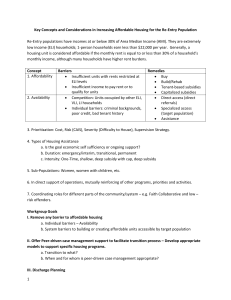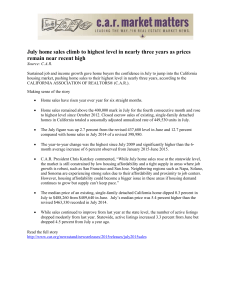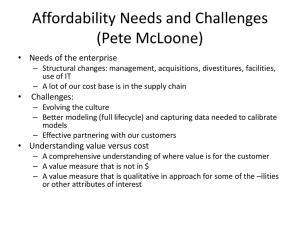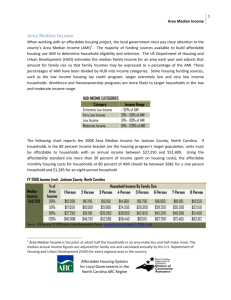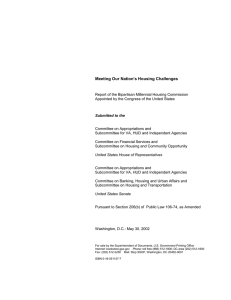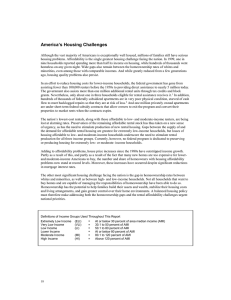Meeting Our Nation’s Housing Challenges Report of the Bipartisan Millennial Housing Commission
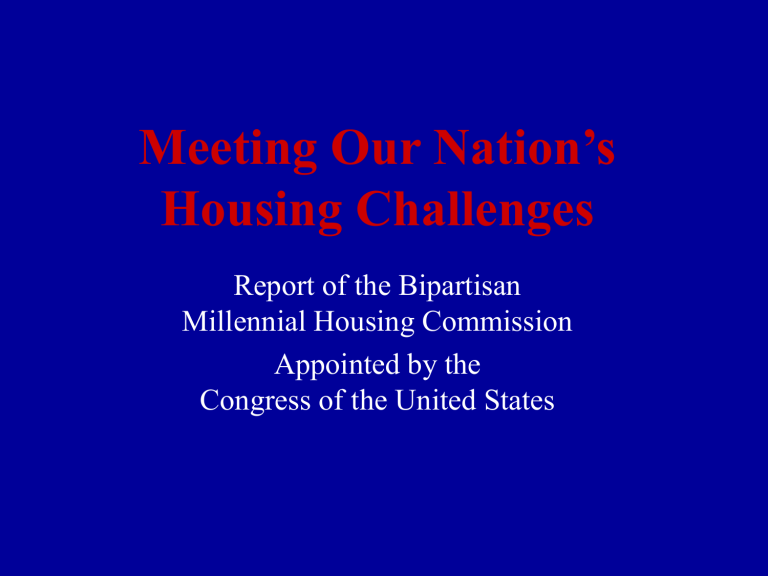
Meeting Our Nation’s
Housing Challenges
Report of the Bipartisan
Millennial Housing Commission
Appointed by the
Congress of the United States
A Congressional Commission
• Authorized in October 1999 (P.L. 106-74)
• Members (22) appointed in December 2000 by chairs and ranking minority members of
– House and Senate Appropriations Committees and
Subcommittees for VA, HUD and Independent
Agencies
– Senate Banking, Housing and Urban Affairs Committee and Housing and Transportation Subcommittee
– House Financial Services Committee and Housing and
Community Opportunity Subcommittee
Meeting Our Nation’s Housing Challenges ‹#›
Legislative Mandate
• To examine, analyze, and explore
– the importance of housing, particularly affordable housing, to the infrastructure of the United States;
– the various possible methods for increasing the role of the private sector in providing affordable housing, including the effectiveness and efficiency of such methods;
– whether the existing programs of HUD work to provide better housing opportunities for families, neighborhoods, and communities, and how such programs can be improved.
Meeting Our Nation’s Housing Challenges ‹#›
Overview of Report
• Thirteen Principal Recommendations
• Fifteen Supporting Recommendations
• Sections on
– Why housing matters
– America’s housing challenges
– The federal role in housing
• Released May 30, 2002
Meeting Our Nation’s Housing Challenges ‹#›
The MHC Vision
To produce and preserve more sustainable, affordable housing in healthy communities to help American families progress up the ladder of economic opportunity
Meeting Our Nation’s Housing Challenges ‹#›
WHY HOUSING MATTERS
• Family stability and childhood outcomes
• Neighborhood quality and access to opportunity
• Neighborhood revitalization
• Household wealth
• Contribution to economic growth and stability
Meeting Our Nation’s Housing Challenges ‹#›
Family Stability and
Childhood Outcomes
• Disruptive moves affect school, job performance
• For welfare-to-work recipients, housing plus job assistance results in better employment outcomes than job assistance alone
• Homeownership has especially positive effects for children in terms of school success and social behavior
• Better-quality housing is related to lower levels of psychological distress and improved educational and economic achievement
Meeting Our Nation’s Housing Challenges ‹#›
Neighborhood Quality and
Access to Opportunity
• Unemployment, crime, high-school dropout, and teen pregnancy rates higher in high-poverty urban, rural areas than elsewhere
• Incidence of depression and anxiety higher among inner-city youth
• Relocating families to better neighborhoods can improve educational, mental health, and behavioral outcomes
Meeting Our Nation’s Housing Challenges ‹#›
Neighborhood Revitalization
• Relocating families can improve outcomes; so can revitalizing distressed neighborhoods
• Important to strengthen schools, provide access to services, connect residents to jobs
• Rundown and abandoned structures can have a contagious effect
• Concentrated public investment in housing can be first step in reclaiming neighborhoods
Meeting Our Nation’s Housing Challenges ‹#›
Household Wealth
• Homeownership
– Insulates households from rising rental costs, home prices
– Enables households to build equity, wealth
• Refinancing can be source of cash for other spending, investment
• Capital gains on home sales add liquidity to the economy, stimulate consumer spending
Meeting Our Nation’s Housing Challenges ‹#›
Contribution to Economic
Growth and Stability
• Housing makes up more than one-third of the nation’s tangible assets
Source:
Bureau of
Economic
Analysis, Survey of Current
Business,
September 2001
Meeting Our Nation’s Housing Challenges ‹#›
The Housing Sector
• In 2000, home building and remodeling accounted for about 4 percent of GDP
• In 2001, new residential construction was associated with roughly 3.5 million jobs nationally and $166 billion in local income
• In 2001, home building was the source of about $65 billion in combined taxes and fees
Meeting Our Nation’s Housing Challenges ‹#›
The Housing Finance System
• Serves as a critical stabilizing force
– Manages risk
– Provides expanded, continuous access to mortgage credit
• Benefits derive largely from
– Evolution of a strong secondary market
– Role of the Federal Housing Administration and the
Government National Mortgage Association
– The Federal Home Loan Banks
Meeting Our Nation’s Housing Challenges ‹#›
AMERICA’S HOUSING
CHALLENGES
• Affordability is the single greatest housing challenge facing the nation
– Extremely-low income households face the greatest problems, but…
– Affordability problems reach across all but the highest income groups
• The burden on working families
• The shrinking rental supply
• Constraints on production and preservation
• Persistent homeownership gaps
Meeting Our Nation’s Housing Challenges ‹#›
Income Group Definitions
• Extremely low income (ELI) = below 30% of area median income (AMI)
• Very low income (VLI) = 30.1 to 50% AMI
• Low income (LI) = 50.1 to 80% AMI
• Lower income = less than 80% AMI
• Moderate income (MI) = 80.1 to 120% AMI
• High income (HI) = above 120% AMI
Meeting Our Nation’s Housing Challenges ‹#›
Measures of Affordability
• Most federal programs measure affordability by the relationship of income to housing costs.
– Spending 30 to 50% of income on housing is considered a “moderate” affordability problem.
– Spending more than 50% of income on housing is considered a “severe” affordability problem.
Meeting Our Nation’s Housing Challenges ‹#›
Owners and Renters Face
Affordability Problems
Source: HUD tabulations of the 1999 American Housing Survey (AHS)
Meeting Our Nation’s Housing Challenges prepared for the MHC.
‹#›
Cost-Burdened Households
• May have incomes too low to cover even modest rental costs
• May live in high-cost markets where even a moderate income is insufficient
• May be unable to earn adequate wages to manage housing plus basic needs due to age, disability, or difficulty finding full-time work
• May need to trade off neighborhood quality in order to lower housing costs
Meeting Our Nation’s Housing Challenges ‹#›
Burden on Working Families
• Of the 11.3 million LI households with severe housing affordability problems in
1999, nearly one-quarter had earnings at least equivalent to full-time work at the minimum wage ($10,712 per year).
• Many families with significantly higher earnings face moderate and severe housing affordability problems.
Meeting Our Nation’s Housing Challenges ‹#›
The Shrinking Rental Supply
• The supply-demand gap affects ELI households and those earning between 60 and 120% of AMI.
• Affordability is a problem primarily for
ELI households.
Source: HUD tabulations of the 1999 AHS prepared for the MHC.
Meeting Our Nation’s Housing Challenges ‹#›
Constraints on Production
• Inadequate financing for multifamily housing in particular
– Insufficient federal subsidy
– Lack of secondary markets for development and construction loans, and loans on small multifamily properties
• Development controls such as local zoning and subdivision regulations
Meeting Our Nation’s Housing Challenges ‹#›
Impediments to Preservation
• Federal programs that under-budget for operations, maintenance, and renovations
• Federal tax policies
• Codes oriented toward new construction rather than moderate rehabilitation
• Inadequacy of federal subsidy needed to cover the gap between affordable rents and operating costs
Meeting Our Nation’s Housing Challenges ‹#›
Persistent Homeownership Gaps
• Despite recent gains, minority and low-income homeownership rates still lag.
Source: U.S. Bureau of the Census, Current Population Survey, 1993 and 1999.
Meeting Our Nation’s Housing Challenges ‹#›
Barriers to Homeownership
• The high cost of housing generally
• Costs associated with buying a home
• Underwriting standards applied by mortgage lenders
• Cost and availability of mortgage credit
• The largest single constraint on lower-income households is lack of savings.
Recent research indicates that face-to-face prepurchase education and counseling reduces loan delinquencies by as much as 34 percent.
Meeting Our Nation’s Housing Challenges ‹#›
THE FEDERAL ROLE IN
HOUSING
• Historical overview
• Programs active today
– Appendix 3 of the Commission report provides a description of past and current federal housing programs.
• Lessons learned
– These lessons informed the Commission’s recommendations.
Meeting Our Nation’s Housing Challenges ‹#›
Lessons Learned: 1 and 2
1.
Affordable housing developments cannot be isolated from the broader community in which they are located and must provide access to decent schools, job opportunities, and transportation.
2.
Decisions about the location and management of affordable housing are best made by state or local governments, rather than the federal government.
Meeting Our Nation’s Housing Challenges ‹#›
Lessons Learned: 3 and 4
3.
The private sector needs the proper incentives to be an effective partner in the federal government’s efforts to address the nation’s housing challenges.
4.
When resources are limited, there are difficult tradeoffs between making rents affordable to the poorest tenants and ensuring that enough income flows into a property to cover the repairs necessary to sustain the structure’s useful life.
Meeting Our Nation’s Housing Challenges ‹#›
PRINCIPAL
RECOMMENDATIONS
• New tools (5)
– Administered by states working with localities
– Targeted to unmet need
– Involve the private sector as appropriate
• Major reforms to existing programs (4)
– Realignment with the programs’ stated missions
• Streamlining of existing programs (4)
– Work well but could benefit from some improvement
Meeting Our Nation’s Housing Challenges ‹#›
NEW TOOLS:
Single-Family Tax Credit
• State could use for two purposes:
– to promote the production or rehabilitation of units in eligible census tracts where production/rehabilitation costs exceed the market value of the completed properties; and/or
– to achieve affordability for low-income buyers by applying the credit against the borrower’s mortgage in the form of prepaid points, below-market interest rates, or other subsidized mortgage terms.
Meeting Our Nation’s Housing Challenges ‹#›
NEW TOOLS:
Preservation Tax Incentive
• Within appropriate federal guidelines and under state oversight, sellers who transfer ownership to a “preservation entity” would qualify for tax relief.
• The “preservation entity” must commit to long-term affordability and comply with criteria established by the state.
Meeting Our Nation’s Housing Challenges ‹#›
NEW TOOLS:
100 Percent Capital Subsidy
• On units earmarked for ELI households
• Rents paid by tenants and would cover operating expenses, including an adequate reserve
• Eligible uses would include new construction, preservation, and acquisition with or without rehabilitation
Meeting Our Nation’s Housing Challenges ‹#›
NEW TOOLS: Financing for
Mixed-Income Rental Housing
• Remove the limits on states’ ability to issue taxexempt debt for specific multifamily properties.
• To be eligible for financing, properties must reserve at least 20 percent of units for families earning no more than 80 percent of AMI.
• Congress should consider requiring states to develop a qualified allocation plan for the use of this resource.
Meeting Our Nation’s Housing Challenges ‹#›
NEW TOOLS: Community
Development Waivers
• Allow governors to reserve up to 15 percent of federal block grant funds to support comprehensive, geographically defined redevelopment projects sponsored by local governments.
• Governors would have limited waiver authority to facilitate the blended use of funds, which would have to be consistent with the purposes of the respective block grant programs.
Meeting Our Nation’s Housing Challenges ‹#›
MAJOR REFORMS TO
EXISTING PROGRAMS:
Public Housing
• Apply private real estate principles
• Provide for an orderly transition at severely distressed properties
• Allow debt financing of capital needs
• Simply the rating of public housing agencies
(PHAs)
• Test new rent-setting mechanisms
• Exempt small PHAs from unnecessary and burdensome reporting requirements
Meeting Our Nation’s Housing Challenges ‹#›
MAJOR REFORMS TO
EXISTING PROGRAMS: FHA
• Restructure the Federal Housing
Administration (FHA) as a wholly owned government corporation within HUD.
– Combine FHA and Ginnie Mae into a single entity based on the model laid out in the
Government Corporation Control Act.
• Provide for more flexible multifamily and single-family operations.
Meeting Our Nation’s Housing Challenges ‹#›
MAJOR REFORMS TO
EXISTING PROGRAMS:
End Homelessness
• Address transitional homelessness by increasing the supply of units affordable to
ELI households using tools such as the 100 percent capital subsidy.
• End chronic homelessness by providing an additional 15,000 units of permanent supportive housing over each of the next 10 years.
Meeting Our Nation’s Housing Challenges ‹#›
MAJOR REFORMS TO
EXISTING PROGRAMS:
Work Requirement
• Fund the services and supports needed to enable families who receive housing assistance to find and maintain employment.
• Fund financial incentives (e.g., income disregards, savings accounts exempt from resource limitations) to enable families to keep more of their earnings.
• Continue to experiment with stepped and flat rents.
Meeting Our Nation’s Housing Challenges ‹#›
STREAMLINE EXISTING
PROGRAMS:
Housing Choice Vouchers
• Improve utilization and success rates
• Increase landlord participation
• Link vouchers to housing production programs
• Link vouchers to work opportunity and selfsufficiency initiatives
• Link vouchers to non-housing programs
• Allow for the flexible use of Section 8 projectbased units
Meeting Our Nation’s Housing Challenges ‹#›
STREAMLINE EXISTING
PROGRAMS:
HOME and the LIHTC
• Improve the HOME Investment
Partnerships Program (HOME)
– Increase funding for HOME
• Improve the Low Income Housing Tax
Credit (LIHTC) program
• Eliminate barriers to combining the LIHTC with HOME and other programs
Meeting Our Nation’s Housing Challenges ‹#›
STREAMLINE EXISTING
PROGRAMS:
Mortgage Revenue Bond
• Repeal the 10-year rule
– Allow housing finance agencies 18 months to issue new mortgages using prepayment funds
• Given the enforcement of Mortgage Revenue
Bong income limits:
– Remove purchase price limits
– Repeal the first-time homebuyer eligibility requirement
– Remove eligibility restrictions on Veterans
– Increase the limits on home improvement loans to the
FHA Title I loan level
Meeting Our Nation’s Housing Challenges ‹#›
STREAMLINE EXISTING
PROGRAMS:
Federal Budget Laws
• Shift appropriations risk away from property owners, lenders, and tenants by
– moving project-based, Section 8 Housing
Assistance Payment contract funding from the discretionary to the mandatory part of the federal budget; and/or
– offering some form of insurance to owners/ lenders to minimize the appropriations risk in their pricing.
Meeting Our Nation’s Housing Challenges ‹#›
SUPPORTING
RECOMMENDATIONS:
1 through 3
1. Increase funding for housing assistance in rural areas.
2. Increase funding for Native American and
Native Hawaiian housing.
3. Establish Individual Homeownership
Development Accounts to help more lowincome households buy homes.
Meeting Our Nation’s Housing Challenges ‹#›
SUPPORTING
RECOMMENDATIONS:
4 through 6
4. Allow housing finance agencies to earn arbitrage.
5. Exempt housing bond purchasers from the
Alternative Minimum Tax.
6. Undertake a study of the Davis-Bacon Act requirements.
Meeting Our Nation’s Housing Challenges ‹#›
SUPPORTING
RECOMMENDATIONS:
7 through 9
7. Address regulatory barriers that either add to the cost of or effectively discourage housing production.
8. Streamline state planning requirements for community development programs.
9. Expand the financing options for small multifamily properties.
Meeting Our Nation’s Housing Challenges ‹#›
SUPPORTING
RECOMMENDATIONS:
10 through 12
10. Foster a secondary market for development and construction lending.
11. Launch a demonstration project for comprehensive community-based work.
12. Improve consumer education about home mortgage lending.
Meeting Our Nation’s Housing Challenges ‹#›
SUPPORTING
RECOMMENDATIONS:
13 through 15
13. Improve manufactured homebuyer and owner access to capital markets.
14. Affirm the importance of the Community
Reinvestment Act.
15. Affirm the importance of the governmentsponsored enterprises.
Meeting Our Nation’s Housing Challenges ‹#›
To Obtain a Copy of the Report
1. Download a copy of the report from the
Commission site at http://www.mhc.gov
.
Both PDF and Word formats are available.
2. The Commission Web site also provides instructions on how to obtain a report from the Government Printing Office.
Meeting Our Nation’s Housing Challenges ‹#›
CD-ROMs
• The report comes with a CD-ROM that includes a
PDF version of the report, a description of the
Commission’s methodology, testimony submitted during hearings, and documents submitted during focus meetings.
• A separate CD-ROM, available through the
National Housing Conference, contains products prepared by MHC consultants and others. To request a copy of this CD-ROM, send an email message to cegan@nhc.org.
Meeting Our Nation’s Housing Challenges ‹#›
